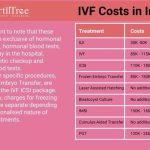How Much Is IVF with Insurance? Your Guide to Costs, Coverage, and Real-Life Insights
In vitro fertilization (IVF) can feel like a rollercoaster—emotionally, physically, and financially. If you’re considering this path to parenthood, one of the first questions that pops up is: How much will it cost me, especially with insurance? You’re not alone in wondering this. Millions of people across the U.S. are navigating the same question, and the answer isn’t always straightforward. Insurance can help, but it’s a puzzle with many pieces—coverage varies by state, plan, and even your personal situation. Let’s break it down together, step by step, so you can feel more confident about what to expect.
This isn’t just about numbers. It’s about understanding what you’re paying for, how insurance fits in, and what you can do to make IVF more affordable. We’ll dive into the latest costs (as of April 2025), explore real-world examples, and share practical tips that go beyond the basics. Plus, we’ll uncover some hidden factors—like mental health costs and new tech—that don’t always make it into the conversation but can change the game.
What Does IVF Actually Cost in 2025?
IVF isn’t cheap, and the price tag can feel overwhelming at first glance. A single cycle in the U.S. typically ranges from $12,000 to $25,000 without insurance, according to recent data from fertility clinics and research studies. But that’s just the starting point. The total cost depends on a bunch of factors: where you live, the clinic you choose, and any extra treatments you might need. With insurance, the out-of-pocket cost can drop significantly—or not, depending on your plan.
Here’s a quick snapshot of what you’re looking at in 2025:
- Base IVF Cycle: $12,000–$17,000 (includes monitoring, egg retrieval, and embryo transfer).
- Medications: $3,000–$7,000 per cycle (these aren’t always covered by insurance).
- Extras: Things like genetic testing ($1,000–$3,000) or freezing embryos ($500–$1,000 per year) can add up.
Insurance can shave thousands off this bill, but only about 25% of Americans have coverage for IVF, per the American Society for Reproductive Medicine (ASRM). If you’re lucky enough to have it, your out-of-pocket costs might range from $2,000 to $10,000 per cycle. Without it? You’re footing the whole thing yourself.
Why Costs Vary So Much
Think of IVF costs like ordering at a restaurant. The “main dish” (the cycle) is one price, but the “sides” (meds, tests, storage) depend on what you need. Living in a big city like New York or Los Angeles? Expect higher prices—sometimes up to $25,000 per cycle—because of demand and overhead. In smaller towns, you might pay closer to $12,000. Clinics also set their own rates, and fancier ones with higher success rates often charge more.
How Insurance Changes the IVF Price Game
Insurance is the wild card in the IVF cost equation. Some people get full coverage, others get a little help, and many get nothing at all. So, how do you figure out where you stand?
Does Your Insurance Cover IVF?
First things first: check your plan. About 20 states in the U.S. have laws requiring some level of fertility coverage as of 2025, but only 10 of them—like New York, Illinois, and California—mandate IVF specifically. Even then, there are rules. You might need to be under 45, have tried other treatments first, or prove you’ve been trying to conceive for a year (six months if you’re over 35).
Here’s what coverage might look like:
- Full Coverage: Rare, but amazing. You might pay just a copay ($50–$200) per visit or procedure.
- Partial Coverage: Common in mandate states. Insurance might cover the cycle but not meds, leaving you with $3,000–$5,000 out of pocket.
- No Coverage: The reality for most. You’re on your own for the full $12,000–$25,000.
A 2024 study from Stanford found that in states with IVF mandates, couples paid 30–50% less out of pocket compared to states without. For example, in New York, where insurance must cover three cycles, a couple might spend $6,000 total instead of $45,000 over three tries.
Real-Life Example: Sarah’s Story
Sarah, a 34-year-old teacher from Chicago, had insurance through her employer in Illinois, a mandate state. Her plan covered two IVF cycles, including monitoring and embryo transfer, but not medications. She paid $4,000 for meds and $500 in copays per cycle—about $9,000 total for two attempts. Without insurance, she’d have faced $30,000+. “It wasn’t cheap,” she says, “but it felt doable compared to friends in other states.”

The Hidden Costs of IVF You Might Not Expect
The price of IVF isn’t just about the clinic bill. There are sneaky extras that can catch you off guard if you’re not prepared. Let’s shine a light on a few.
Emotional and Mental Health Costs
IVF is a marathon, not a sprint, and it can take a toll on your mind. A 2024 National Institutes of Health (NIH) study found that 40% of IVF patients experience anxiety or depression during treatment. Therapy isn’t usually covered by insurance, and sessions can cost $100–$200 each. Over a year of treatment, that’s an extra $1,200–$2,400.
Tip: Look for free support groups through clinics or online communities. They won’t replace therapy, but they can ease the load.
Time Off Work
Egg retrieval and embryo transfers mean doctor visits—lots of them. If you don’t have paid leave, you could lose $500–$1,000 in wages per cycle, depending on your job. Some employers offer fertility leave (yay, tech companies!), but it’s not common yet.
Travel and Childcare
Live far from a clinic? Gas, flights, or even hotel stays add up. One couple I spoke to drove 200 miles round-trip for each appointment, spending $300 on gas alone. If you’ve already got kids, childcare during those long appointments might cost $50–$100 a pop.
Interactive Quiz: What’s Your IVF Cost Profile?
Wondering how much IVF might cost you? Take this quick quiz to get a ballpark idea. Jot down your answers and tally them up!
- Do you live in a state with an IVF mandate? (e.g., NY, CA, IL)
- Yes: +1 point
- No: +3 points
- Does your insurance cover fertility treatments?
- Yes, fully: +0 points
- Yes, partially: +2 points
- No: +4 points
- Will you need extras like genetic testing or donor eggs?
- Yes: +3 points
- No: +1 point
Score:
- 1–3: Likely $2,000–$5,000 out of pocket with insurance.
- 4–6: Around $5,000–$10,000.
- 7+: Brace for $15,000+ per cycle.
This isn’t exact, but it’s a starting point. Call your insurance to confirm!
New Tech That Could Lower IVF Costs (and How Insurance Plays In)
Science is moving fast, and some breakthroughs might make IVF cheaper—or at least more efficient. Here’s what’s on the horizon in 2025.
Simplified Lab Systems
Researchers in Australia developed a “lab-on-a-chip” that cuts lab costs by up to 90%. It’s not everywhere yet, but clinics adopting it could drop cycle prices to $8,000–$10,000. Insurance might cover this sooner since it’s cost-effective, but it’s still in testing phases.
AI for Embryo Selection
AI tools can now pick the best embryos with 85% accuracy, per a 2024 study in Nature Medicine. This boosts success rates, meaning fewer cycles—and less money spent overall. Some insurances are starting to cover AI add-ons (about $500), seeing it as a smart investment.
Frozen Embryo Transfers
Freezing embryos for later is getting cheaper—around $500 per transfer versus $12,000 for a fresh cycle. If your insurance covers freezing (check your policy!), you could save big by banking embryos and transferring them over time.
How to Make IVF More Affordable with Insurance
Even with insurance, IVF can strain your wallet. Here are some practical moves to stretch your coverage and cut costs.
Step-by-Step Guide to Maximize Coverage
- Call Your Insurance: Ask about “infertility benefits” and get specifics—cycles, meds, extras. Write it down!
- Appeal Denials: If they say no, fight back. A 2023 ASRM report says 1 in 3 denials get overturned with a doctor’s letter.
- Use an HSA/FSA: Pre-tax accounts can cover copays or meds—up to $3,000 a year for some plans.
- Shop Pharmacies: Meds vary wildly in price. One reader saved $1,000 by switching to a mail-order pharmacy.
- Ask About Discounts: Clinics often have sliding scales or multi-cycle packages (e.g., $20,000 for three tries).
✔️ Do This, ❌ Don’t Do That
✔️ Do negotiate with your clinic—some knock off 10–15% if you pay upfront.
❌ Don’t assume meds are covered; double-check.
✔️ Do look for grants (e.g., Baby Quest offers up to $15,000).
❌ Don’t skip the fine print—exclusions can sneak up on you.
State-by-State Breakdown: Where Insurance Helps Most
Where you live can make or break your IVF budget. Here’s a handy table based on 2025 data from state health departments and fertility advocacy groups:
| State | IVF Mandate? | Typical Out-of-Pocket with Insurance | Notes |
|---|---|---|---|
| New York | Yes | $2,000–$6,000 | Covers 3 cycles, meds often extra |
| California | Yes | $3,000–$8,000 | New law mandates coverage in 2025 |
| Texas | No | $10,000–$20,000 | Rare employer coverage |
| Illinois | Yes | $2,500–$7,000 | Strong mandate, 2-cycle limit |
| Florida | No | $12,000–$25,000 | No state help, high clinic costs |
Fun Fact: California’s new mandate, signed in 2024, forces insurers to cover IVF starting this year. Posts on X show people celebrating lower costs, but some worry premiums might rise for everyone.
The Social Side: What People Are Saying in 2025
IVF costs are a hot topic online. On X, users in April 2025 are buzzing about prices ranging from $17,000 to $25,000 per cycle, with donor eggs hitting $20,000–$45,000. One thread debated whether insurance mandates raise premiums for all—a real concern, but studies show the hike is small (about 1–2% per person). Google Trends data backs this up: searches for “IVF cost with insurance” spiked 20% this year, especially in mandate states.
People aren’t just talking numbers. They’re sharing hacks—like using fertility apps to track cycles for free—or venting about the stress. One user wrote, “IVF feels like a second mortgage, even with insurance.” It’s raw, relatable, and a reminder that you’re not in this alone.
Case Study: Mark and Lisa’s Journey
Mark and Lisa, a couple from New Jersey, started IVF in 2024. Their state mandates coverage, so their insurance paid for three cycles. Here’s how it broke down:
- Cycle 1: $3,500 out of pocket (meds + copays). No pregnancy.
- Cycle 2: $3,000 (meds cheaper via a discount program). Success!
- Total: $6,500 + a healthy baby girl.
Without insurance, they’d have spent $40,000+. “It was still hard,” Lisa says, “but knowing most of it was covered kept us going.” Their story shows how insurance can turn a dream into reality—though it’s not perfect.
Poll: What’s Your Biggest IVF Worry?
Let’s hear from you! Pick one and share your thoughts in the comments:
- A) The cost, even with insurance
- B) Whether insurance will cover enough
- C) The emotional stress of it all
- D) Finding a good clinic
Your vote helps others see what matters most!
Beyond the Price Tag: IVF’s Bigger Picture
IVF isn’t just about money—it’s about hope, family, and tough choices. Insurance can lighten the load, but it’s not a magic wand. A 2024 NIH study found that couples with coverage were 40% more likely to try IVF than those without, yet success rates hover around 30–40% per cycle for women under 35. That gap means multiple tries, more costs, and a rollercoaster of emotions.
The Equity Question
Who gets IVF? Coverage often favors higher earners with employer plans, leaving low-income families out. Advocacy groups are pushing for broader access, and some states (like New York) offer grants up to $10,000 for qualifying residents. It’s a start, but there’s a long way to go.
A Glimpse at the Future
By 2030, experts predict IVF could cost less as tech improves and more states mandate coverage. Imagine paying $5,000 per cycle with insurance—possible if simplified systems catch on. For now, though, it’s about working with what you’ve got.
Wrapping Up: Your Next Steps
So, how much is IVF with insurance? It could be $2,000 or $20,000—it depends on your plan, state, and needs. The key is to dig into your coverage, plan for the extras, and explore every option. Call your insurer today, ask about benefits, and don’t be shy about negotiating with clinics or seeking grants.
You’ve got this. IVF is a big step, but with the right info, it’s less of a mystery and more of a journey you can navigate. What’s your plan? Drop a comment—I’d love to hear where you’re at!





